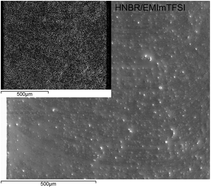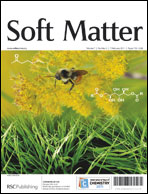In order to achieve good morphological, mechanical, structural, and thermal properties of a polymer electrolyte, ionic-liquid-in-polymer electrolytes have been explored. It was found that 1-ethyl-3-methylimidazolium, 1-butyl-3-methylimidazolium, and 1-butyl-1-methylpyrrolidinium tetrafluoroborate (EMImBF4, BMImBF4, and BMPyBF4), hexafluorophosphate (EMImPF6, BMImPF6, and BMPyPF6), and bis(trifluoromethylsulfonyl)imide (EMImTFSI, BMImTFSI, and BMPyTFSI) in hydroxy-functionalized multi-walled carbon nanotubes (MWCNT–OH) reinforced hydrogenated poly(acrylonitrile-co-1,3-butadiene) (HNBR) produce homogeneous solids. HNBR/MWCNT–OH/ionic liquid solid electrolytes were prepared by melt compounding of the nanotubes in the elastomer, mixing with curing system, curing, and immersion in the ionic liquid. Cross-linked with 12.9 wt% of the curing system (per total composite weight prior to ionic liquid sorption), these HNBR-based electrolytes displayed elastomeric properties and high tensile strength (up to 24 MPa). HNBR/MWCNT–OH/ionic liquid composites had the elongation at break up to 378% (BMPyTFSI) at the room temperature and ionic liquid concentrations up to 18 wt% (BMImTFSI). Thermal analysis showed that the Tg of HNBR/MWCNT–OH/ionic liquid systems decreased as a function of increasing ionic liquid content at the constant polymer content in a composite.


 Please wait while we load your content...
Please wait while we load your content...